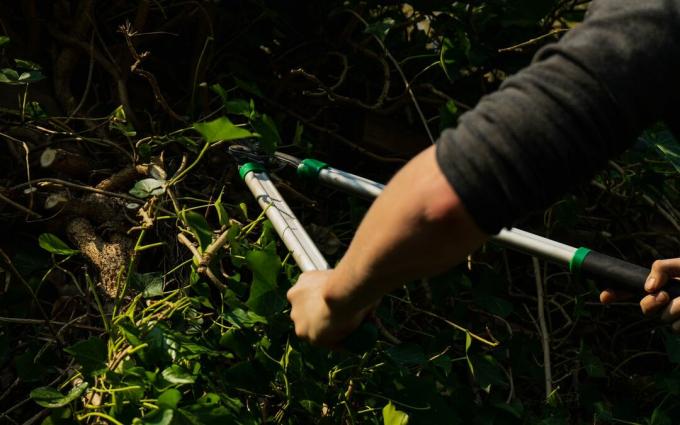Either you love or you hate the fast-growing climber. We show what to consider when planting, caring for and cutting ivy.

Ivy (Hedera helix) is the plant of love. Do you still remember the carefully drawn little heart on your first love letter? Perhaps your loved one even left you a quickly scribbled heart on a short note this morning? Logical that it's about the human heart, right? The funny thing is that the heart symbol bears no resemblance to the real heart, it even looks more like an ivy leaf. In fact, the heart symbol does not represent a real heart as such, but an ivy leaf.
contents
- Ivy: characteristics, origin and meaning
- Buying ivy: what to watch out for
- Ivy species and varieties
-
Plant ivy
- Plant ivy as a hedge
- Ivy as a houseplant in a pot
-
Caring for ivy
- Water and fertilize ivy
- Cut ivy
- Propagate ivy
- Remove ivy
- Ivy diseases and pests
- Fight yellow leaves on ivy
- Is ivy poisonous?
From the properties and origin to the choice of variety and everything about planting and care, you will find all the important information about ivy below. With the right tips, the easy-care plant can easily be kept in the garden or as a houseplant.
Ivy: characteristics, origin and meaning
Ivy is incredibly durable and resilient. Ivy can live up to 450 years. What some curse and what others appreciate about it has made ivy a symbol of love. It stands for loyalty and long, deep love that can take a lot. The leaves of the plant do not always look the same. Young leaves are lobed and more angular in shape. Only the leaves on older shoots have the curved curves of a heart. The older shoots no longer crawl, as is known from ivy, but rather grow like a shrub or liana. Only these shoots develop the small white-green flowers in autumn, which are so incredibly important for many pollinators. Hardly any other plant delivers such a large amount of nectar so late in the year, into October. The bluish fruits that appear in January are also an excellent source of food for birds in harsh winters. In addition, ivy is evergreen and offers a dense privacy screen even in winter. Whether for hiding a bird or to protect the garden from prying eyes, humans and animals benefit from this plant.

The native plant is hardy without any problems and can not only be used for facade greening, as a ground cover or opaque Ivy hedge Use in the garden, but also make an extremely decorative houseplant.
Buying ivy: what to watch out for
When it comes to buying ivy, not much can go wrong, because the plants have a strong will to survive. Even weak specimens have a good chance of recovering quickly. Still, you should make sure that you find a healthy plant. Well worth it to look after Spider mites To keep an eye out. Other than that, it's important to choose the right type. Depending on the situation, the plant has to meet the various requirements.
Summary Here's what to keep in mind when buying ivy:
- The right kind
- Winter hardiness
- Maximum height of the plant
- Strength of the adherent roots
- Plant health
Ivy species and varieties
The genus of ivy comprises at least seven species and over 400 varieties. We will introduce you to the best known in the following.
- The most well-known species in Central Europe is the common ivy (Hedera helix). It is native and optimally adapted to the conditions. Pretty varieties are for example ‘Eva’ with their white leaf margin or ‘Gold Hummingbird’ with a golden yellow margin inside the leaf. Those who like it golden yellow will probably find this variety too "Goldheart" fallen with a golden yellow heart in the middle of the sheet. The variety ‘Baltica’ on the other hand, there is a strong contrast between its dark green leaves and the very light to almost white leaf veins.
- The Algerian ivy (Hedera algeriensis) often has a conspicuous white border around the graceful leaves patterned in shades of green. It is extremely decorative and reaches a height of around 4 m. Its winter resistance is limited, however, as it can only withstand temperatures down to -12 ° C.

- The Irish ivy (hedera hibernica) stands out due to its large leaves. In height, however, it usually does not reach more than 10 m.
- As the name suggests, the Persian ivy comes from (Hedera colchica) from warmer regions. For this reason, the species tolerates heat very well, but can withstand temperatures down to -18 ° C. It does not have as strong adhesive roots as common ivy, which is why it is well suited for greening facades. The leaves of this species are large and heart-shaped.
Plant ivy
Ivy is a wonderful plant and completely uncomplicated to plant. Although he prefers a shady spot, he can even get along well in the sun. Choose a time in autumn or spring for planting. A cloudy day is ideal for this. In order to guarantee the plant an optimal start, you can put our in the ground Plantura organic universal fertilizer incorporate. If you want a high quality garden soil like the peat-free and sustainable one Plantura organic universal soil use, fertilization when planting is not necessary. Details on the Plants of ivy can be found in this special article.
Plant ivy as a hedge
Ivy is rapidly developing into a dense privacy screen. However, in order for it to grow into a magnificent hedge, you must give it the opportunity to do so. Above all, what he needs is one thing: a stable climbing aid. This gives him the shape of his growth and within a very short time he will entwine it so well that it can no longer be seen. Occasional pruning will keep the hedge in shape. Like your own Creating an ivy hedge is easy, find out here.
Ivy as a houseplant in a pot
The beautiful climbing plant doesn't necessarily have to stay outside. The ivy also feels at home in the house. Ivy can be integrated into the home in a variety of ways, climbing along shelves or banisters, or decoratively as a traffic light. However, it quickly becomes too dry for him when the humidity drops in winter. Then you should spray the plant with lime-free water from time to time. She also likes it a little cooler in winter than in summer. Otherwise, however, the ivy is quite easy to care for and gets along well with less light. Tips too Planting and caring for ivy in the room get here.

Summary planting ivy:
- Ideally, choose a shady location, but the ivy can also tolerate a little sun
- The right time to plant is autumn or spring
- Work in some slow release fertilizer, manure or compost when planting
- With a suitable climbing aid, ivy can be planted perfectly as a hedge
- If ivy is kept as a houseplant, you should ensure that there is sufficient humidity
Caring for ivy
Ivy is probably one of the easiest plants to look after outdoors. Since it is also at home in Germany, it is ideally adapted to the conditions in this country. General information about the Care of ivy You will find here.
Water and fertilize ivy
In a suitable location in partial shade or shade, the ivy does not need any further care. Long-term fertilization in spring, however, stimulates growth. A long-term fertilizer like ours is particularly suitable for this Plantura organic universal fertilizer. Crap or compost also work as fertilizers. In a dry location, you should water the plant from time to time. If the plant grows in a shady place anyway, this will hardly be necessary.
Cut ivy
Cutting back is an important issue. The plant grows quickly and should therefore be cut back regularly. Fortunately, ivy is pretty insensitive to pruning, and you can safely prune it vigorously. The best time to do this is in spring, when no birds are yet nesting in the dense foliage. Like your Prune ivy properly, we have put together for you here.

Summary of caring for ivy:
- In principle, ivy is a very easy to care for plant
- Once a year in spring you can fertilize your ivy with slow release fertilizer, compost or manure
- Occasional watering is necessary in dry locations
- Because of its rapid growth, the ivy must be pruned regularly; this is best done in spring and can also be more radical
Propagate ivy
Ivy is durable and resilient. So it's no wonder that it is also very prolific. It constantly forms new roots as soon as its tendrils touch the earth. You can easily take advantage of this if you want to propagate the ivy yourself. Whether as a sinker or cutting, the Propagation of the ivy is quick and easy. You can find out how exactly you do this here.
Remove ivy
In its lifetime ivy is a beautiful plant and an excellent habitat for numerous animals. But if you get embarrassed about having to remove the stubborn growth, you will quickly find yourself cursing. Removing ivy isn't fun, it is hard work. The most important thing is to remove the root entirely. To ensure this, you should dig them up as carefully as possible. Then it is time to remove the traces left by the ivy above ground. You should proceed very carefully, especially on facades. Everything for Removal of ivy from the garden, from trees or walls and facades, we have summarized here for you.
Ivy diseases and pests
Ivy is a fairly insensitive and very strong plant. It is therefore hardly affected by pests and diseases, at most when it is weakened. This happens, for example, as a result of drought or dry air. Then have Spider mites (Tetranychidae) easy game. Especially at Ivy as a houseplant this can become a problem in winter. You can recognize the infestation by the webs and the small, light-silvery dots on the leaves that the spider mites leave behind. It is best to prevent the infestation by placing the plant in a place with high humidity or by spraying it regularly with water that is low in lime. If it is already too late, then you should separate the plant and first rinse off the worst in the shower. In order to kill the remaining spider mites, it is advisable to put a transparent bag over the plant for at least two weeks. Spider mites cannot tolerate the high humidity that develops under the bag.

Fight yellow leaves on ivy
The ivy gets some yellow leaves every spring. This is quite normal, because at this time of the year the old leaves are exchanged for new and fresh ones. But if the number of yellow leaves is above normal, then you should check whether something is wrong with your plant. Reasons for yellow leaves on ivy can be waterlogging, drought, spider mites or too dense growth. You can find out what to do then here.
Is ivy poisonous?
Ivy is poisonous to humans and many animals. The tempting berries in particular can be dangerous. But you don't need to fear the climbing plant. The leaves and berries are so bitter that it would hardly occur to anyone to consume large quantities of them. What exactly is it with the Poisonous Ivy and what to do if you experience symptoms, you can find out here.



